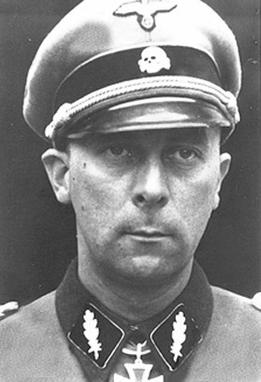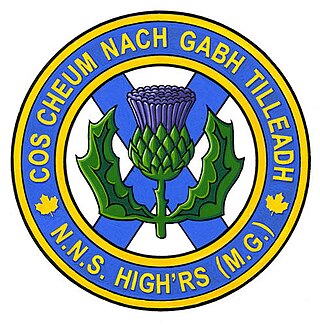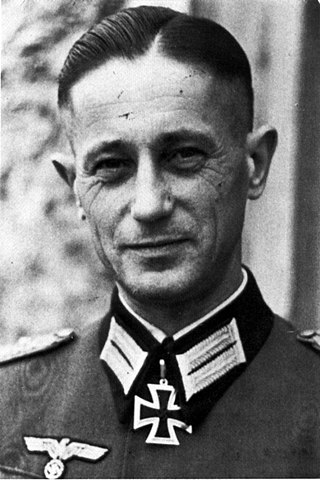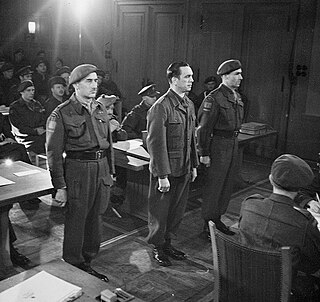
The Waffen-SS was the combat branch of the Nazi Party's paramilitary Schutzstaffel (SS) organisation. Its formations included men from Nazi Germany, along with volunteers and conscripts from both occupied and unoccupied lands. It was disbanded in May 1945.

The Malmedy massacre was a German war crime committed by soldiers of the Waffen-SS on 17 December 1944 at the Baugnez crossroads near the city of Malmedy, Belgium, during the Battle of the Bulge. Soldiers of Kampfgruppe Peiper summarily killed eighty-four U.S. Army prisoners of war (POWs) who had surrendered after a brief battle. The Waffen-SS soldiers had grouped the U.S. POWs in a farmer's field, where they used machine guns to shoot and kill the grouped POWs; the prisoners of war who survived the gunfire of the massacre were killed with a coup de grâce gunshot to the head.

The 1st SS Panzer Division Leibstandarte SS Adolf Hitler or SS Division Leibstandarte, abbreviated as LSSAH, began as Adolf Hitler's personal bodyguard unit, responsible for guarding the Führer's person, offices, and residences. Initially the size of a regiment, the LSSAH eventually grew into an elite division-sized unit during World War II.

The SS Division Hitlerjugend or 12th SS Panzer Division "Hitlerjugend" was a German armoured division of the Waffen-SS during World War II. The majority of its junior enlisted men were drawn from members of the Hitler Youth, while the senior NCOs and officers were from other Waffen-SS divisions.

Kurt Meyer was an SS commander and convicted war criminal of Nazi Germany. He served in the Waffen-SS and participated in the Battle of France, Operation Barbarossa, and other engagements during World War II. Meyer commanded the 12th SS Panzer Division Hitlerjugend during the Allied invasion of Normandy, and was a recipient of the Knight's Cross of the Iron Cross with Oak Leaves and Swords.

Wilhelm Mohnke was a German military officer who was one of the original members of the SchutzstaffelSS-Stabswache Berlin formed in March 1933. Mohnke, who had joined the Nazi Party in September 1931, rose through the ranks to become one of Adolf Hitler's last remaining general officers at the end of World War II in Europe.

Operation Charnwood was an Anglo-Canadian offensive that took place from 8 to 9 July 1944, during the Battle for Caen, part of the larger Operation Overlord in the Second World War. The operation was intended to capture the German-occupied city of Caen, which was an important objective for the Allies during the opening stages of Overlord. It was also hoped that the attack would forestall the transfer of German armoured units from the Anglo-Canadian sector to the American sector to the west, where an offensive was being prepared. The British and Canadians advanced on a broad front and by the evening of the second day had taken Caen up to the Orne and Odon rivers.

The I SS Panzer Corps was a German armoured corps of the Waffen-SS. It saw action on both the Western and Eastern Fronts during World War II.

Fritz Witt was a Waffen-SS commander during the Nazi era. During World War II, he served with the SS Division Leibstandarte before taking command of the SS Division Hitlerjugend. He was killed in action in June 1944.

The North Nova Scotia Highlanders was an infantry regiment of the Canadian Army founded in 1936. In 1954, it was amalgamated with The Pictou Highlanders and 189 LAA RCA Battery to form 1st Battalion, The Nova Scotia Highlanders (North).

Hubert Meyer was a German SS commander during the Nazi era and a post-war activist. In World War II, Meyer served in the Waffen-SS and had junior postings with the Leibstandarte SS Adolf Hitler; he briefly commanded the SS Division Hitlerjugend in 1944. After the war, he became active in HIAG, a Waffen-SS negationist lobby group, and was HIAG's last chairman before the group dissolved in 1992.

Fritz Kraemer was a high-ranking Waffen-SS commander and war criminal during the Nazi era. During World War II, Kraemer initially served with the 13th Infantry Division. In January 1943, he was appointed as a staff officer of the I SS Panzer Corps commanded by Sepp Dietrich. Kraemer was admitted into the SS on 1 August 1944. During the battles in Normandy, Krämer acted as Dietrich’s deputy, and eventually succeeded Hubert Meyer as commander of the SS Division Hitlerjugend. He was in charge of the division until 13 November 1944.
The Chenogne massacre was a war crime committed by members of the 11th Armored Division, an American combat unit, near Chenogne, Belgium, on January 1, 1945, during the Battle of the Bulge.

The governments of the German Empire and Nazi Germany ordered, organized, and condoned a substantial number of war crimes, first in the Herero and Namaqua genocide and then in the First and Second World Wars. The most notable of these is the Holocaust, in which millions of European Jewish, Polish, and Romani people were systematically abused, deported, and murdered. Millions of civilians and prisoners of war also died as a result of German abuses, mistreatment, and deliberate starvation policies in those two conflicts. Much of the evidence was deliberately destroyed by the perpetrators, such as in Sonderaktion 1005, in an attempt to conceal their crimes.
Cyril Frost Kennedy, ED was a Progressive Conservative party member of the House of Commons of Canada.

The Battle of Le Mesnil-Patry during the Second World War, was the last attack by an armoured battle group conducted by Canadian troops in Normandy in June 1944. The Queen's Own Rifles of Canada of the 8th Canadian Infantry Brigade of the 3rd Canadian Division, supported by the 6th Armoured Regiment of the 2nd Canadian Armoured Brigade attacked the village of Le Mesnil-Patry in Normandy, to advance southwards towards the higher ground of Hill 107 to the west of Cheux. The attack was intended to support a larger operation by the 50th (Northumbrian) Infantry Division and the 7th Armoured Division to capture the city of Caen and to advance in the centre of the bridgehead next to the First US Army. The battle was a German defensive success but the greater German objective of defeating the invasion by a counter-offensive also failed.
The Ascq massacre was a massacre of 86 men on 1 April 1944 in Ascq, France, by the Waffen-SS during the Second World War.

Ardenne Abbey, the Abbey of Our Lady of Ardenne, is a former Premonstratensian abbey founded in the 11th century and located near Saint-Germain-la-Blanche-Herbe in Calvados, near Caen, France. It is now occupied by the Institute of Contemporary Publishing Archives. Several buildings of the abbey have been preserved, including the church. These are protected as historic monuments.
The Reverend Walter Leslie Brown was a Canadian military chaplain who was attached to the Sherbrooke Fusilier Regiment, 2nd Canadian Armoured Brigade during Operation Overlord. He was murdered by Waffen-SS soldiers after he had surrendered. At the time of his capture he had been wearing the uniform of a Canadian army chaplain.

The Normandy massacres were a series of killings in-which approximately 156 Canadian and two British prisoners of war (POWs) were murdered by soldiers of the 12th SS Panzer Division during the Battle of Normandy in World War II. The majority of the murders occurred within the first ten days of the Allied invasion of France. The killings ranged in scale from spontaneous murders of individual POWs, to premeditated mass executions involving dozens of victims. Colonel Kurt Meyer, a commander in the 12th SS Panzer Division, was the only perpetrator charged for his role in the atrocities.



















